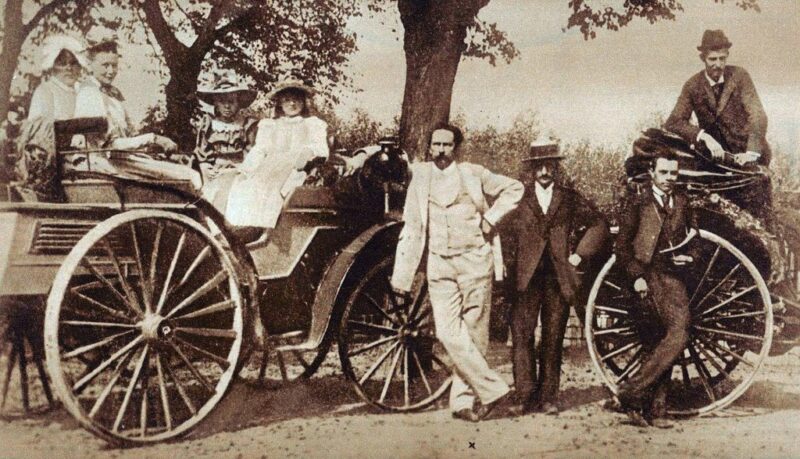Who Invented the Car & When? (History of the Car)
-
Chris Dinesen Rogers
- Last updated:

You have to keep an open mind when asking who and when the car was invented. The first examples look nothing like the decked-out, fully loaded vehicles we drive today. You may think that American industrialist Henry Ford takes this place in history. However, transportation changed forever on New Year’s Eve 1879 when Carl Benz took his one-cylinder, two-stroke car to the road.
Benz would later patent his motor wagon with its gasoline-powered engine on January 29, 1886. The public got its first look at the three-wheeled vehicle in July 1886. Bear in mind that horses limited how far one could travel in a day. A gasoline-powered car couldn’t have been a better game-changer.
Before Gasoline Engines
Carl Benz wasn’t the only inventor working on the concept of the automobile. Other types of vehicles existed before he revved up his car. The idea of going faster than the average pulling horse had been in the works for a while. Perhaps unsurprisingly, Leonardo da Vinci envisioned a self-propelled vehicle in 1478.
Steam supplied the power in the early days, with French inventor Nicolas-Joseph Cugnot’s entry into the development in 1769. It may surprise you to learn that the electric vehicle wasn’t a new riff on the horseless carriage. Scottish inventor Robert Anderson made the first example in the 1830s, although his invention had a non-rechargeable battery.
The Benz Era

It’s safe to say that Carl Benz revolutionized the horseless carriage. Innovation moved quickly toward the turn of the century, with modifications in steering and later Benz’s first production car, the Benz Velo, in 1894. Even his wife Bertha got caught up in the tidal wave with her 112-mile round trip≈ in Benz’s vehicle. He would later team up with Gottlieb Daimler to set the next stage in the car’s development.
Henry Ford’s Legacy
While Benz was making history, business magnate Henry Ford was forging his own path in automobiles. Ford’s entry was his 1896 Ford Quadricycle. Meanwhile, brothers Charles and Frank Duryea focused on perfecting the vehicle’s engine with their 1896 first USA-made gasoline car. The industry took off in the late 1890s to the early 1900s, with 30 manufacturers in the country.
Henry Ford took the world by storm in 1908 with the Ford Motor Company’s production of the Model T. The difference with this car was its affordability. Earlier entries were out of the reach of the everyday consumer. It was possible because of the simultaneous introduction of mass production at Ford’s plant. That practice kept costs down while allowing for a higher output.
Additional tweaks and modifications in the production process brought the cost down to $300 by 1925, or about $5,077.22 in today’s money. The Model T became the car to own at such affordable prices. The company continued to produce the vehicle until 1927. However, Ford left another indelible mark on history and manufacturing.
Labor Practices and Ford’s Legacy

Labor practices were anything but fair up into the early 20th century. Henry Ford changed all that with the implementation of a decent wage for his workers in 1914. Previously, they made only $2.34 for a 9-hour shift. Ford upped their pay to $5 for an 8-hour day. The increase went from $69 a day to $148.09. It’s not hard to imagine what an impact it had on his employees and the economy.
Ford also introduced the 5-day, 40-hour work week in 1925. Both policy changes sent shockwaves through the industry. While it may have rocked the worlds of many automobile manufacturers, it also was a stroke of genius by Ford to foster employee and brand loyalty. In yet another way, he was far ahead of his time.
The Early 1900s
The industry continued to expand with William Crapo Durant’s incorporation of General Motors in 1908. It was another brilliant move for the time because it consolidated the industry. Other smaller manufacturers existed, but the market was so fragmented that it was challenging for anyone to make their market with so much competition.
It continued to play out throughout the 1900s. By 1929, only three major players dominated the auto industry: Chrysler, General Motors, and Ford. However, the Great Depression and World War II would have lasting impacts that would influence the direction of the manufacturing sector. Ford would pivot to support the war effort, branching out into aviation.
The Mid 1900s
After weathering the war, the manufacturers that still existed continued to innovate. Other inventors also had their mark on history, including Swedish engineer Nils Bohlin with his 1959 three-point seat belt. Initially, this device was used on race cars and fighter planes. Racing had been a part of the automobile’s legacy from the start. However, all changed with the 1949 Oldsmobile Rocket 88.
The vehicle was the first of the so-called muscle cars that would dominate the industry for decades. The interesting thing is its legacy with moonshine and bootleggers. The scofflaws needed a fast ride to outrun law enforcement. The 1970 Clean Air Act and the 1973–1974 oil embargo were almost the end of an era for muscle cars. However, fans made sure they didn’t fall off the track.
The 1980s and the Future of the Car

The automobile industry had to reinvent itself following the changes in the global economy. The massive cars of the earlier years became smaller and more fuel efficient. Aerodynamics became a primary motivator for design changes that took the boxy look of older models to the curved lines defining today’s vehicles. Nevertheless, there’s no denying the automobile’s place in the past and future.
According to Hedges Company, an estimated 290.8 million registered vehicles will travel on American roads in 2022. That’s nearly a 17-percent increase in the last 10 years. However, the wave of the future will include a new driving companion, the autonomous vehicle. Industry experts expect the figure to rise to 54.2 million by 2024. A whole new era of the car awaits.
Conclusion
The car has traveled a long way since Leonardo da Vinci conceived of a self-propelling vehicle. No longer are rural populations isolated from the rest of the world. The automobile connected people. It also introduced us to another form of bureaucracy: the speeding ticket. Harry Myers went down in history in 1904 in Dayton, Ohio, when he received the first citation. His crime was going 12 miles per hour.
Featured Image Credit: 1898 Benz Velo Automuseum Dr. Carl Benz, 2014(Bahnfrend, via Wikimedia Commons CC BY-SA 4.0)
Contents

